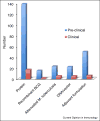Tuberculosis vaccines - perspectives from the NIH/NIAID Mycobacteria vaccine testing program
- PMID: 28750280
- PMCID: PMC5626602
- DOI: 10.1016/j.coi.2017.07.008
Tuberculosis vaccines - perspectives from the NIH/NIAID Mycobacteria vaccine testing program
Abstract
The development of novel vaccine candidates against infections with Mycobacterium tuberculosis has highlighted our limited understanding of immune mechanisms required to kill M. tuberculosis. The induction of a Th1 immunity is vital, but new studies are required to identify other mechanisms that may be necessary. Novel vaccines formulations that invoke effector cells such as innate lymphoid cells may provide an environment that promote effector mechanisms including T cell and B cell mediated immunity. Identifying pathways associated with killing this highly successful infectious agent has become critical to achieving the goal of reducing the global tuberculosis burden.
Copyright © 2017 Elsevier Ltd. All rights reserved.
Figures


References
-
- Hunter RL. Tuberculosis as a three-act play: A new paradigm for the pathogenesis of pulmonary tuberculosis. Tuberculosis (Edinb) 2016;97:8–17. Provides an excellent overview of the immunopathogenesis of M. tuberculosis in humans and examines the role of immunity in the development of the various sequelae associated with infection. - PMC - PubMed
-
- Schubert OT, Aebersold R. Microbial Proteome Profiling and Systems Biology: Applications to Mycobacterium tuberculosis. Adv Exp Med Biol. 2015;883:235–54. - PubMed
-
- Lee J, et al. Proteomic analysis of extracellular vesicles derived from Mycobacterium tuberculosis. Proteomics. 2015;15(19):3331–7. - PubMed
-
- Aagaard C, et al. A multistage tuberculosis vaccine that confers efficient protection before and after exposure. Nat Med. 2011;17(2):189–94. - PubMed
Publication types
MeSH terms
Substances
Grants and funding
LinkOut - more resources
Full Text Sources
Other Literature Sources
Medical

